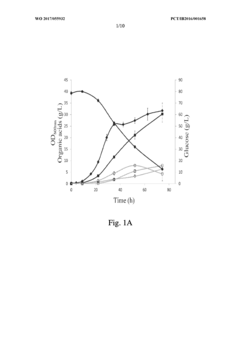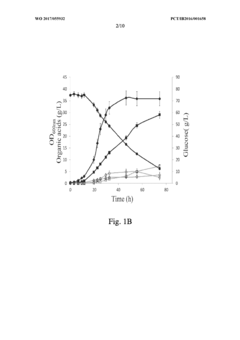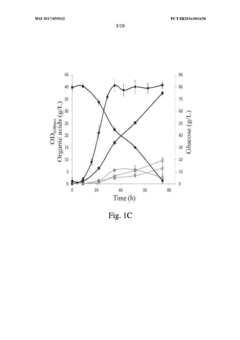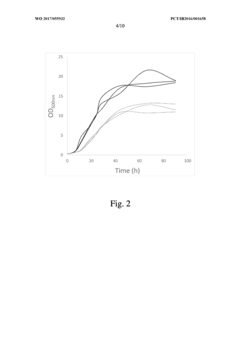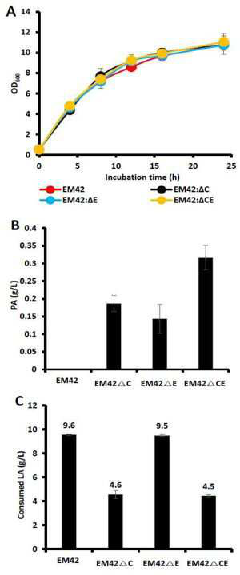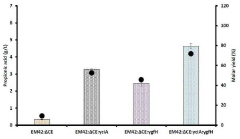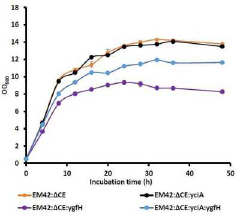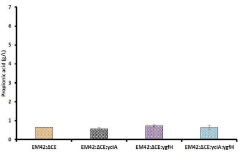Propionic Acid in Scientific Research: Emerging Trends
JUL 3, 20259 MIN READ
Generate Your Research Report Instantly with AI Agent
Patsnap Eureka helps you evaluate technical feasibility & market potential.
Propionic Acid Research Background and Objectives
Propionic acid, a three-carbon short-chain fatty acid, has been a subject of scientific interest for decades due to its diverse applications in various industries. The research landscape surrounding propionic acid has evolved significantly, driven by advancements in biotechnology, chemical engineering, and environmental sciences. This report aims to provide a comprehensive overview of the emerging trends in scientific research involving propionic acid, highlighting the key developments and future directions in this field.
The historical context of propionic acid research dates back to its discovery in the mid-19th century. Initially, studies focused primarily on its chemical properties and natural occurrence. However, as industrial applications expanded, research efforts shifted towards optimizing production methods and exploring new uses. In recent years, there has been a renewed interest in propionic acid, particularly in the context of sustainable chemistry and bio-based production.
One of the primary objectives of current propionic acid research is to develop more efficient and environmentally friendly production methods. Traditional petrochemical-based processes are being challenged by bio-based alternatives, which utilize renewable resources and microbial fermentation. This shift aligns with global sustainability goals and the growing demand for green chemicals.
Another significant trend is the exploration of propionic acid's potential in the pharmaceutical and biomedical fields. Recent studies have investigated its antimicrobial properties, its role in gut health, and its potential as a building block for drug synthesis. These emerging applications are opening new avenues for research and development in the medical sciences.
In the agricultural sector, propionic acid research is focusing on its use as a food preservative and animal feed additive. Scientists are investigating novel formulations and delivery methods to enhance its efficacy while minimizing environmental impact. This research is crucial for addressing food security challenges and improving livestock health.
The materials science field has also seen increased interest in propionic acid derivatives. Researchers are exploring their potential in biodegradable plastics, coatings, and advanced materials. This trend is driven by the growing demand for sustainable alternatives to conventional petroleum-based products.
As we look towards the future, several key objectives are shaping the direction of propionic acid research. These include scaling up bio-based production processes, discovering new applications in emerging industries, and improving the overall sustainability profile of propionic acid and its derivatives. Interdisciplinary collaborations are becoming increasingly important, bringing together expertise from microbiology, chemical engineering, and materials science to address complex challenges.
The historical context of propionic acid research dates back to its discovery in the mid-19th century. Initially, studies focused primarily on its chemical properties and natural occurrence. However, as industrial applications expanded, research efforts shifted towards optimizing production methods and exploring new uses. In recent years, there has been a renewed interest in propionic acid, particularly in the context of sustainable chemistry and bio-based production.
One of the primary objectives of current propionic acid research is to develop more efficient and environmentally friendly production methods. Traditional petrochemical-based processes are being challenged by bio-based alternatives, which utilize renewable resources and microbial fermentation. This shift aligns with global sustainability goals and the growing demand for green chemicals.
Another significant trend is the exploration of propionic acid's potential in the pharmaceutical and biomedical fields. Recent studies have investigated its antimicrobial properties, its role in gut health, and its potential as a building block for drug synthesis. These emerging applications are opening new avenues for research and development in the medical sciences.
In the agricultural sector, propionic acid research is focusing on its use as a food preservative and animal feed additive. Scientists are investigating novel formulations and delivery methods to enhance its efficacy while minimizing environmental impact. This research is crucial for addressing food security challenges and improving livestock health.
The materials science field has also seen increased interest in propionic acid derivatives. Researchers are exploring their potential in biodegradable plastics, coatings, and advanced materials. This trend is driven by the growing demand for sustainable alternatives to conventional petroleum-based products.
As we look towards the future, several key objectives are shaping the direction of propionic acid research. These include scaling up bio-based production processes, discovering new applications in emerging industries, and improving the overall sustainability profile of propionic acid and its derivatives. Interdisciplinary collaborations are becoming increasingly important, bringing together expertise from microbiology, chemical engineering, and materials science to address complex challenges.
Market Analysis for Propionic Acid Applications
The global market for propionic acid has been experiencing steady growth, driven by its diverse applications across various industries. The food and feed industry remains the largest consumer of propionic acid, accounting for a significant portion of the market share. In this sector, propionic acid is primarily used as a preservative in animal feed and food products, helping to extend shelf life and prevent mold growth.
The pharmaceutical industry has also emerged as a key growth driver for propionic acid applications. The compound is utilized in the production of various medications, including those for treating fungal infections and certain skin conditions. As healthcare needs continue to evolve globally, the demand for propionic acid in pharmaceutical applications is expected to rise.
In the agricultural sector, propionic acid finds application as a crop protection agent and herbicide. With the increasing focus on sustainable farming practices and the need for improved crop yields, the use of propionic acid in agriculture is projected to grow. Additionally, the compound's effectiveness in controlling weeds and its relatively low environmental impact make it an attractive option for farmers and agricultural businesses.
The chemical industry represents another significant market for propionic acid. It serves as a crucial intermediate in the production of various chemicals, including plastics, solvents, and other industrial compounds. The growing demand for these end products, particularly in developing economies, is expected to fuel the market growth for propionic acid in this sector.
Emerging applications in the personal care and cosmetics industry are also contributing to the expanding market for propionic acid. Its antimicrobial properties make it a valuable ingredient in skincare products, deodorants, and other personal care items. As consumer awareness of product ingredients increases, the demand for natural and effective preservatives like propionic acid is likely to grow.
Geographically, North America and Europe currently dominate the propionic acid market, owing to their well-established food and feed industries, as well as stringent regulations promoting the use of safe preservatives. However, the Asia-Pacific region is expected to witness the fastest growth in the coming years, driven by rapid industrialization, increasing population, and rising disposable incomes.
The pharmaceutical industry has also emerged as a key growth driver for propionic acid applications. The compound is utilized in the production of various medications, including those for treating fungal infections and certain skin conditions. As healthcare needs continue to evolve globally, the demand for propionic acid in pharmaceutical applications is expected to rise.
In the agricultural sector, propionic acid finds application as a crop protection agent and herbicide. With the increasing focus on sustainable farming practices and the need for improved crop yields, the use of propionic acid in agriculture is projected to grow. Additionally, the compound's effectiveness in controlling weeds and its relatively low environmental impact make it an attractive option for farmers and agricultural businesses.
The chemical industry represents another significant market for propionic acid. It serves as a crucial intermediate in the production of various chemicals, including plastics, solvents, and other industrial compounds. The growing demand for these end products, particularly in developing economies, is expected to fuel the market growth for propionic acid in this sector.
Emerging applications in the personal care and cosmetics industry are also contributing to the expanding market for propionic acid. Its antimicrobial properties make it a valuable ingredient in skincare products, deodorants, and other personal care items. As consumer awareness of product ingredients increases, the demand for natural and effective preservatives like propionic acid is likely to grow.
Geographically, North America and Europe currently dominate the propionic acid market, owing to their well-established food and feed industries, as well as stringent regulations promoting the use of safe preservatives. However, the Asia-Pacific region is expected to witness the fastest growth in the coming years, driven by rapid industrialization, increasing population, and rising disposable incomes.
Current Challenges in Propionic Acid Research
Despite significant advancements in propionic acid research, several challenges persist in this field. One of the primary obstacles is the high production cost associated with traditional fermentation methods. The current processes often require expensive substrates and complex purification steps, making large-scale production economically challenging. Researchers are grappling with optimizing fermentation conditions to enhance yield and productivity while reducing operational costs.
Another significant challenge lies in the development of more efficient and sustainable production methods. The conventional petrochemical-based production of propionic acid is environmentally unsustainable, prompting a shift towards bio-based production. However, achieving comparable yields and purity levels through biological routes remains a hurdle. Scientists are exploring novel microbial strains and genetic engineering techniques to overcome these limitations, but progress has been incremental.
The purification of propionic acid from fermentation broths presents another technical challenge. Current separation methods often result in low recovery rates and product purity, necessitating multiple purification steps. This not only increases production costs but also generates significant waste. Developing more efficient separation technologies, such as advanced membrane processes or novel extraction methods, is crucial for improving the overall production efficiency.
Researchers are also facing challenges in expanding the application scope of propionic acid. While it has established uses in food preservation and animal feed, there is a growing interest in exploring its potential in biodegradable plastics and pharmaceuticals. However, adapting propionic acid for these new applications often requires modifications to its properties or the development of novel derivatives, which presents both chemical and regulatory challenges.
The environmental impact of propionic acid production and use is another area of concern. As sustainability becomes increasingly important, researchers are tasked with developing greener production processes and exploring the biodegradability of propionic acid-based products. This includes investigating the use of renewable feedstocks and minimizing waste generation throughout the production cycle.
Lastly, there is a need for more comprehensive life cycle assessments of propionic acid production and its various applications. Such studies are crucial for understanding the true environmental and economic impacts of different production methods and end-uses, guiding future research and development efforts in more sustainable directions.
Another significant challenge lies in the development of more efficient and sustainable production methods. The conventional petrochemical-based production of propionic acid is environmentally unsustainable, prompting a shift towards bio-based production. However, achieving comparable yields and purity levels through biological routes remains a hurdle. Scientists are exploring novel microbial strains and genetic engineering techniques to overcome these limitations, but progress has been incremental.
The purification of propionic acid from fermentation broths presents another technical challenge. Current separation methods often result in low recovery rates and product purity, necessitating multiple purification steps. This not only increases production costs but also generates significant waste. Developing more efficient separation technologies, such as advanced membrane processes or novel extraction methods, is crucial for improving the overall production efficiency.
Researchers are also facing challenges in expanding the application scope of propionic acid. While it has established uses in food preservation and animal feed, there is a growing interest in exploring its potential in biodegradable plastics and pharmaceuticals. However, adapting propionic acid for these new applications often requires modifications to its properties or the development of novel derivatives, which presents both chemical and regulatory challenges.
The environmental impact of propionic acid production and use is another area of concern. As sustainability becomes increasingly important, researchers are tasked with developing greener production processes and exploring the biodegradability of propionic acid-based products. This includes investigating the use of renewable feedstocks and minimizing waste generation throughout the production cycle.
Lastly, there is a need for more comprehensive life cycle assessments of propionic acid production and its various applications. Such studies are crucial for understanding the true environmental and economic impacts of different production methods and end-uses, guiding future research and development efforts in more sustainable directions.
Current Propionic Acid Research Methodologies
01 Production methods of propionic acid
Various methods are employed for the production of propionic acid, including fermentation processes, chemical synthesis, and catalytic reactions. These methods often involve the use of specific microorganisms, catalysts, or chemical precursors to efficiently produce propionic acid on an industrial scale.- Production methods of propionic acid: Various methods are employed for the production of propionic acid, including fermentation processes, chemical synthesis, and catalytic reactions. These methods often involve the use of specific microorganisms, catalysts, or chemical precursors to efficiently produce propionic acid on an industrial scale.
- Applications of propionic acid in food preservation: Propionic acid and its salts are widely used as food preservatives due to their antimicrobial properties. They are effective in preventing mold growth and extending the shelf life of various food products, particularly in bakery items, dairy products, and animal feed.
- Use of propionic acid in pharmaceutical formulations: Propionic acid and its derivatives find applications in the pharmaceutical industry. They are used in the synthesis of various drugs, as well as in the formulation of certain medications, particularly those related to topical treatments and dermatological products.
- Environmental and industrial applications of propionic acid: Propionic acid is utilized in various environmental and industrial applications, including wastewater treatment, as a chemical intermediate in the production of plastics and other materials, and as a component in de-icing solutions and herbicides.
- Analytical methods for propionic acid detection and quantification: Various analytical techniques are employed for the detection and quantification of propionic acid in different matrices. These methods include chromatography, spectroscopy, and electrochemical techniques, which are crucial for quality control in industries using propionic acid and for research purposes.
02 Applications of propionic acid in food preservation
Propionic acid and its salts are widely used as food preservatives due to their antimicrobial properties. They are effective in inhibiting the growth of mold and certain bacteria, thereby extending the shelf life of various food products, particularly baked goods and dairy products.Expand Specific Solutions03 Use of propionic acid in pharmaceutical formulations
Propionic acid and its derivatives find applications in the pharmaceutical industry. They are used in the formulation of various medications, including topical treatments for skin conditions and as intermediates in the synthesis of certain drugs.Expand Specific Solutions04 Industrial applications of propionic acid
Propionic acid has diverse industrial applications beyond food and pharmaceuticals. It is used in the production of plastics, herbicides, and as a chemical intermediate in various manufacturing processes. Its properties make it valuable in industries such as agriculture, polymers, and chemical synthesis.Expand Specific Solutions05 Purification and recovery of propionic acid
Various methods and processes have been developed for the purification and recovery of propionic acid from reaction mixtures or fermentation broths. These techniques aim to improve the efficiency of propionic acid production and ensure high-quality output for different applications.Expand Specific Solutions
Key Players in Propionic Acid Industry
The emerging trends in scientific research involving Propionic Acid are characterized by a competitive landscape in a maturing industry. The market is experiencing steady growth, driven by increasing applications in food preservation, pharmaceuticals, and chemical synthesis. Technologically, advancements are being made in production methods and novel applications. Key players like PetroChina, Dow Global Technologies, and Evonik Operations are leading industrial research, while academic institutions such as Jiangnan University, The Ohio State University, and the University of Queensland are contributing to fundamental research. The collaboration between industry and academia is accelerating innovation in this field, focusing on sustainable production processes and expanding the acid's potential uses.
Evonik Operations GmbH
Technical Solution: Evonik has developed innovative production methods for propionic acid using renewable resources. Their approach involves fermenting biomass-derived sugars using proprietary microorganisms, achieving high yields and purity[1]. The company has also explored catalytic oxidation of bio-based propanol to propionic acid, enhancing sustainability[2]. Additionally, Evonik has invested in process intensification, implementing advanced separation technologies like reactive distillation to improve efficiency and reduce energy consumption in propionic acid production[3].
Strengths: Sustainable production from renewable resources, high yield and purity, energy-efficient processes. Weaknesses: Potential higher production costs compared to petrochemical routes, reliance on biomass availability.
Novomer, Inc.
Technical Solution: Novomer has pioneered a novel approach to propionic acid production using carbon dioxide (CO2) as a feedstock. Their proprietary catalyst technology enables the direct conversion of CO2 and ethylene to propionic acid under mild conditions[4]. This process significantly reduces carbon footprint compared to traditional petrochemical routes. Novomer has also developed a continuous flow reactor system that enhances productivity and allows for easier scale-up[5]. The company is exploring the integration of renewable ethylene sources to further improve the sustainability of their propionic acid production method.
Strengths: Utilization of CO2 as feedstock, reduced carbon footprint, potential for integration with renewable resources. Weaknesses: Reliance on ethylene availability, potential catalyst cost and longevity issues.
Breakthrough Studies in Propionic Acid Research
Improved propionibacterium strains for the production of propionic acid
PatentWO2017055932A2
Innovation
- Genome shuffling between selected Propionibacterium strains, such as P. acidipropionici ATCC 4875 and P. acidipropionici ATCC 55737, to generate novel strains with enhanced growth rates and propionic acid production, utilizing genetic material exchange to create strains with improved metabolic pathways and regulatory mechanisms.
Bioproduction of Propionic Acid from Levulinic Acid by Utilizing Recombinant Pseudomonas putida
PatentInactiveKR1020240029628A
Innovation
- A transgenic Pseudomonas putida strain is developed by deleting prpC and prpE genes and expressing yciA and ygfH genes, utilizing levulinic acid as a substrate to enhance propionic acid production through a levulinic acid-inducible expression system, optimizing the metabolic pathway to improve titer and yield.
Environmental Impact of Propionic Acid Production
The production of propionic acid has significant environmental implications that warrant careful consideration. The traditional petrochemical-based production methods have been associated with substantial carbon emissions and energy consumption. However, recent research trends indicate a shift towards more sustainable production processes.
One of the emerging approaches is the use of renewable feedstocks for propionic acid production. Biomass-derived substrates, such as glycerol from biodiesel production or lignocellulosic materials, are being explored as alternative raw materials. This shift not only reduces dependence on fossil fuels but also contributes to the circular economy by utilizing waste streams from other industries.
Biotechnological production methods, particularly those involving microbial fermentation, are gaining traction due to their potential for lower environmental impact. These processes often operate under milder conditions, requiring less energy input compared to chemical synthesis routes. Additionally, the use of genetically engineered microorganisms has shown promise in improving yield and selectivity, potentially reducing waste generation.
Water consumption and wastewater management are critical environmental concerns in propionic acid production. Recent research has focused on developing closed-loop systems and advanced wastewater treatment technologies to minimize water usage and reduce the release of pollutants. Membrane-based separation techniques and advanced oxidation processes are being investigated for their efficacy in treating propionic acid-containing effluents.
The environmental impact of propionic acid extends beyond its production to its applications. As a food preservative and animal feed additive, propionic acid can contribute to reducing food waste and improving livestock feed efficiency. This indirect environmental benefit is an important consideration in the overall lifecycle assessment of propionic acid.
Efforts to reduce the carbon footprint of propionic acid production have led to the exploration of carbon capture and utilization (CCU) technologies. Some researchers are investigating the feasibility of using captured CO2 as a feedstock for propionic acid synthesis, potentially creating a carbon-neutral or even carbon-negative production process.
Life Cycle Assessment (LCA) studies are increasingly being conducted to comprehensively evaluate the environmental impact of different propionic acid production routes. These assessments consider factors such as greenhouse gas emissions, energy consumption, water usage, and land use change, providing valuable insights for decision-making in process selection and optimization.
As regulatory pressures and consumer demand for sustainable products continue to grow, the propionic acid industry is likely to see further innovations aimed at minimizing environmental impact. This may include the development of novel catalysts for more efficient synthesis, the integration of renewable energy sources in production facilities, and the optimization of supply chains to reduce transportation-related emissions.
One of the emerging approaches is the use of renewable feedstocks for propionic acid production. Biomass-derived substrates, such as glycerol from biodiesel production or lignocellulosic materials, are being explored as alternative raw materials. This shift not only reduces dependence on fossil fuels but also contributes to the circular economy by utilizing waste streams from other industries.
Biotechnological production methods, particularly those involving microbial fermentation, are gaining traction due to their potential for lower environmental impact. These processes often operate under milder conditions, requiring less energy input compared to chemical synthesis routes. Additionally, the use of genetically engineered microorganisms has shown promise in improving yield and selectivity, potentially reducing waste generation.
Water consumption and wastewater management are critical environmental concerns in propionic acid production. Recent research has focused on developing closed-loop systems and advanced wastewater treatment technologies to minimize water usage and reduce the release of pollutants. Membrane-based separation techniques and advanced oxidation processes are being investigated for their efficacy in treating propionic acid-containing effluents.
The environmental impact of propionic acid extends beyond its production to its applications. As a food preservative and animal feed additive, propionic acid can contribute to reducing food waste and improving livestock feed efficiency. This indirect environmental benefit is an important consideration in the overall lifecycle assessment of propionic acid.
Efforts to reduce the carbon footprint of propionic acid production have led to the exploration of carbon capture and utilization (CCU) technologies. Some researchers are investigating the feasibility of using captured CO2 as a feedstock for propionic acid synthesis, potentially creating a carbon-neutral or even carbon-negative production process.
Life Cycle Assessment (LCA) studies are increasingly being conducted to comprehensively evaluate the environmental impact of different propionic acid production routes. These assessments consider factors such as greenhouse gas emissions, energy consumption, water usage, and land use change, providing valuable insights for decision-making in process selection and optimization.
As regulatory pressures and consumer demand for sustainable products continue to grow, the propionic acid industry is likely to see further innovations aimed at minimizing environmental impact. This may include the development of novel catalysts for more efficient synthesis, the integration of renewable energy sources in production facilities, and the optimization of supply chains to reduce transportation-related emissions.
Regulatory Framework for Propionic Acid Use
The regulatory framework for propionic acid use is complex and multifaceted, reflecting its diverse applications across industries. In the food industry, propionic acid is widely recognized as a safe preservative (E280) by regulatory bodies worldwide. The U.S. Food and Drug Administration (FDA) has classified it as Generally Recognized as Safe (GRAS), allowing its use in various food products within specified limits.
In the European Union, the European Food Safety Authority (EFSA) has established guidelines for propionic acid usage, setting maximum permissible levels in different food categories. These regulations are periodically reviewed and updated based on emerging scientific evidence and risk assessments.
For agricultural applications, particularly as a mold inhibitor in animal feed, regulatory bodies such as the FDA and the European Medicines Agency (EMA) have established guidelines for its use. These regulations often specify maximum inclusion rates and withdrawal periods to ensure food safety and animal welfare.
In the pharmaceutical industry, propionic acid's use as an excipient or in drug formulations is subject to stringent regulations. Regulatory agencies like the FDA and the European Medicines Agency (EMA) require thorough documentation and testing to ensure its safety and efficacy in pharmaceutical products.
Environmental regulations also play a crucial role in governing propionic acid use. Many countries have implemented strict guidelines for its handling, storage, and disposal to minimize environmental impact. The U.S. Environmental Protection Agency (EPA) and the European Chemicals Agency (ECHA) have established protocols for risk assessment and management of propionic acid in industrial settings.
Occupational health and safety regulations address the potential hazards associated with propionic acid exposure in workplace environments. Organizations such as the Occupational Safety and Health Administration (OSHA) in the United States have set permissible exposure limits and mandated safety measures for workers handling this compound.
As scientific research continues to uncover new applications and potential risks associated with propionic acid, regulatory frameworks are expected to evolve. Emerging trends in research may lead to the development of more refined regulations, addressing specific use cases and potential long-term effects. This dynamic regulatory landscape necessitates ongoing collaboration between researchers, industry stakeholders, and regulatory bodies to ensure the safe and effective use of propionic acid across various sectors.
In the European Union, the European Food Safety Authority (EFSA) has established guidelines for propionic acid usage, setting maximum permissible levels in different food categories. These regulations are periodically reviewed and updated based on emerging scientific evidence and risk assessments.
For agricultural applications, particularly as a mold inhibitor in animal feed, regulatory bodies such as the FDA and the European Medicines Agency (EMA) have established guidelines for its use. These regulations often specify maximum inclusion rates and withdrawal periods to ensure food safety and animal welfare.
In the pharmaceutical industry, propionic acid's use as an excipient or in drug formulations is subject to stringent regulations. Regulatory agencies like the FDA and the European Medicines Agency (EMA) require thorough documentation and testing to ensure its safety and efficacy in pharmaceutical products.
Environmental regulations also play a crucial role in governing propionic acid use. Many countries have implemented strict guidelines for its handling, storage, and disposal to minimize environmental impact. The U.S. Environmental Protection Agency (EPA) and the European Chemicals Agency (ECHA) have established protocols for risk assessment and management of propionic acid in industrial settings.
Occupational health and safety regulations address the potential hazards associated with propionic acid exposure in workplace environments. Organizations such as the Occupational Safety and Health Administration (OSHA) in the United States have set permissible exposure limits and mandated safety measures for workers handling this compound.
As scientific research continues to uncover new applications and potential risks associated with propionic acid, regulatory frameworks are expected to evolve. Emerging trends in research may lead to the development of more refined regulations, addressing specific use cases and potential long-term effects. This dynamic regulatory landscape necessitates ongoing collaboration between researchers, industry stakeholders, and regulatory bodies to ensure the safe and effective use of propionic acid across various sectors.
Unlock deeper insights with Patsnap Eureka Quick Research — get a full tech report to explore trends and direct your research. Try now!
Generate Your Research Report Instantly with AI Agent
Supercharge your innovation with Patsnap Eureka AI Agent Platform!
